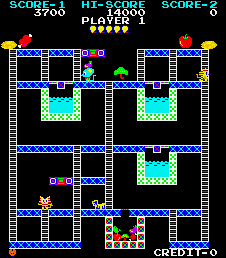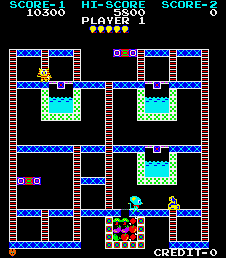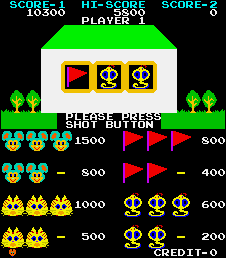 The Game: Super Mouse is on the case. He’s trying to grab all the food from every level of the screen. While he’s on the case, cats are on the chase, trying to catch Super Mouse. Two blocks of cheese on the top levels of the screen can be dropped on top of the cats, or the cats can be tricked into chasing Super Mouse over a trap door that’ll dump them in a water tank. But the cats don’t stay gone for long. Super Mouse advances to a new level when he takes every piece of food back to his secret hideout. (Taito, 1982)
The Game: Super Mouse is on the case. He’s trying to grab all the food from every level of the screen. While he’s on the case, cats are on the chase, trying to catch Super Mouse. Two blocks of cheese on the top levels of the screen can be dropped on top of the cats, or the cats can be tricked into chasing Super Mouse over a trap door that’ll dump them in a water tank. But the cats don’t stay gone for long. Super Mouse advances to a new level when he takes every piece of food back to his secret hideout. (Taito, 1982)
Memories: Barely remembered by anyone, Super Mouse was one of the hundreds of games that heralded the 1982 arcade “boom,” when no idea was too strange or too derivative. Super Mouse combines elements of Donkey Kong and Turtles (not exactly two games that one hears mentioned in the same breath a lot) to create something intriguingly unique. But it’s not all that and a piece of cheese.
 Super Mouse is simply too tough. The odds are tilted too far in favor of the house: the player most likely won’t get very far in his attempt to help Super Mouse navigate the maze, evade the cats, and get all the good, and chances are that most players got discouraged far too easily by the difficulty level. (While I’m all in favor of making someone work to enjoy their 25 cents worth of fun, cutesy games like this often attracted younger players instead of a “hardcore” audience. Give ’em a break.)
Super Mouse is simply too tough. The odds are tilted too far in favor of the house: the player most likely won’t get very far in his attempt to help Super Mouse navigate the maze, evade the cats, and get all the good, and chances are that most players got discouraged far too easily by the difficulty level. (While I’m all in favor of making someone work to enjoy their 25 cents worth of fun, cutesy games like this often attracted younger players instead of a “hardcore” audience. Give ’em a break.)
Making things even stranger: if Super Mouse clears a level, the player is presented with a “slot machine” screen where he can try to rack up bonuses by lining up the pictures, fruit-machine- style. It’s a jarring departure from the more video-game-like structure of the rest of the game.
style. It’s a jarring departure from the more video-game-like structure of the rest of the game.
Super Mouse could’ve been a contender, maybe even the big cheese, but as it is, it squeaked by in the arcade, barely noticed.
